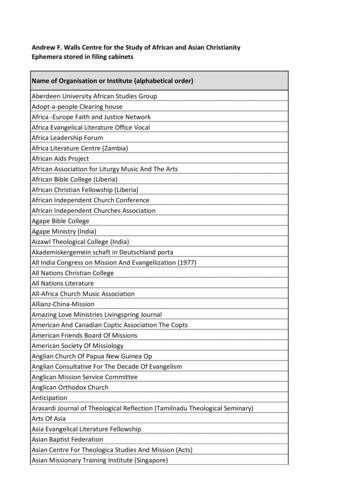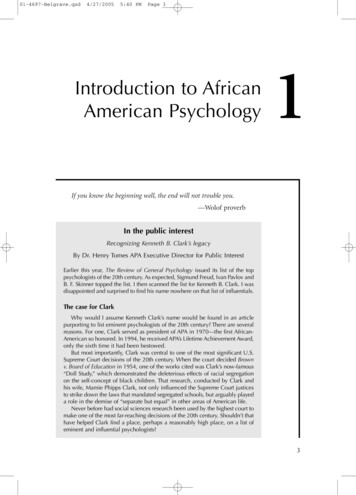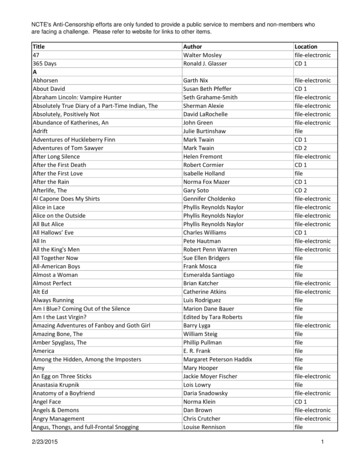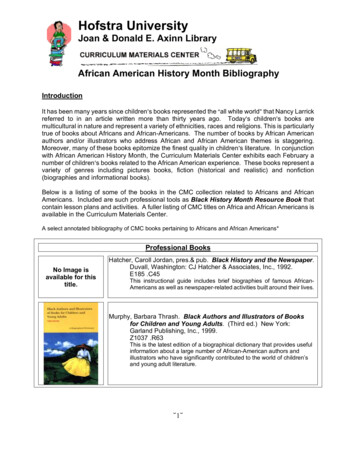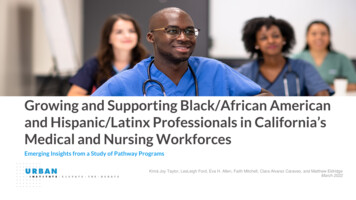
Transcription
Growing and Supporting Black/African Americanand Hispanic/Latinx Professionals in California’sMedical and Nursing WorkforcesEmerging Insights from a Study of Pathway ProgramsKimá Joy Taylor, LesLeigh Ford, Eva H. Allen, Faith Mitchell, Clara Alvarez Caraveo, and Matthew EldridgeMarch 2022
The California Health Care Workforce Lacks Diversity45%14%of California residentsidentify as Black/AfricanAmerican or Hispanic/Latinxof California medical schoolgraduates identify asBlack/African American orHispanic/Latinx 9%of practicing physicians inCalifornia identify asBlack/African American orHispanic/Latinx California’s nursing workforce has a similar underrepresentation of Black/African Americanand Hispanic/Latinx nurses as they move through their education and careers.Sources: "Quick Facts: California," US Census Bureau, accessed March 28, 2022, https://www.census.gov/quickfacts/CA; California Physicians, “California Health Care AlmanacQuick Reference Guide” (Oakland, CA: California Health Care Foundation, 2021); LPOC Organization, “In a Diverse State, California’s Latino Doctors Push for More of Their Own,”Latinx Physicians of California, January 2, 2018, ifornias-latino-doctors-push/; and Joanne Spetz, Lela Chu, and Lisel Blash,Diversity of California’s Nursing Workforce Chartbook (San Francisco: University of California, San Francisco, 2018).
A Diverse Health Care Workforce Can HelpImprove HealthHealth equityA more diverse healthcare workforce canimprove and promotethe followingoutcomesSource: HHS Advisory Committee on Minority Health, Reflecting America’s Population: Diversifying a Competent Health Care Workforce for the 21stCentury (Washington, DC: US Department of Health and Human Services, Office of Minority Health, 2011).Patient choice andsatisfactionPatient-clinician trustAccess to high-qualityand culturally effectivecareDiverse representationin leadership,policymaking, andresearch
Pathway Programs Are Instrumental in Increasing theDiversity of the Health Professional Workforce Pathway programs are designed to recruit and support people fromsystemically excluded groups in health care professions. Investments have been made to recruit Black/African Americanand Hispanic/Latinx students into medical professions, though notenough to achieve equity. Comparable pathway programs for Black/African American andHispanic/Latinx nursing students and professionals are lacking.
Effective Pathway Programs Offer Academic, Financial,Social, and Institutional Supports and IncludeSustainability and Accountability lExamplesSummer enrichment programs, exam preparation, study tips, academic andcareer advising, research opportunitiesScholarship, tuition waivers, room and board, financial literacy education,paid internshipsMentorship, affinity groups, social activitiesCommitment to diversity, equity, and inclusion in an organization's policiesand practices, curricula, and operationsSustainabilitySupport to build program capacity and ensure long-term sustainabilityand accountabilitthrough program monitoring activities and research and evaluationy5
What Could This Look Like for California?Photo by NeONBRAND on Unsplash
Provide Academic Supports to Increase Youth’s Exposure toHealth Professions and to Strengthen the Academic Skills of ThoseInterested in Health Professional Careers Invest in K–12 pathway programs to increase exposure to and knowledge of nursing andmedical professions among Black/African American and Hispanic/Latinx students and provideadditional support for those interested in nursing and medical professions. Support programs that strengthen the academic skills, as needed, of prospective and enrolledBlack/African American and Hispanic/Latinx nursing and medical students who have thepotential to succeed and thrive with additional support. Invest in linkages across programs at each educational level to ensure students progress alongtheir desired career pathways in medicine and nursing. Example: Associate Degrees for Transfer in Health Majors at the Community Colleges andCalifornia State University System
Expand Financial Supports for New and Existing Initiatives toRecruit and Retain Black/African American and Hispanic/LatinxStudents in Health Professions Schools Provide funding to community colleges and public four-year colleges and universities tosupport comprehensive pathway programs to recruit and retain undergraduates fromsystemically and structurally excluded groups. Fund mentoring and support programs for Black/African American and Hispanic/Latinxclinicians who are already practicing. Expand direct financial support to students, including unconditional grants, scholarships, andstipends that defray the living and other expenses associated with obtaining education andtraining, and give students a freedom of choice in specialty and geographic area of practice. Continue to support and increase funding for scholarship programs with a track record ofincreasing opportunities for students from systemically and structurally excluded groups,like the Health Resources and Services Administration’s Health Careers Opportunity Programand Centers of Excellence, which have various pathway programs.
Implement and Sustainably Fund Culturally AppropriateSocial Supports to Positively Affect Students’ andProfessionals' Experiences and Retention Financially incentivize nursing and medical schools to create formal mentoringprograms and other initiatives to diversify their faculties and student bodies. Adopt cohort model approaches to provide continued mentoring and otherresources to students from acceptance into through graduation from medical ornursing school. Support the development and maintenance of health profession mentorshipprogramming, including guidance, training, and compensation for mentors. Develop and implement an evaluation metric for mentors and advisers to assess ifthey are effective and unbiased, need additional skills, or should be let go.
Mandate the Use of Holistic Admissions Practicesin California Nursing and Medical Schools Holistic admissions criteria value applicants’ qualities such ascommitment, resilience, work ethic, and passion for service, as wellas socioeconomic disadvantage; these practices can promote greaterdiversity in nursing and medical schools. Funding is needed for the development and implementation oftraining for recruitment and admissions staff to remove implicit racialbias from their processes. Example: UC Davis School of Medicine admissions adjustment forsocioeconomic disadvantage
Recruit California Talent Health professions schools can invest in “growingtheir own” pools of qualified candidates byconducting early outreach in local communities andcreating pathway programming to nursing andmedical schools for systemically and structurallyexcluded K–12 and college students. Example: UC Davis Undergraduate and CommunityCollege Outreach Programs
Create Pathways to Support Ancillary Health CareWorkers’ Entry into Nursing and Medical Careers About half of medical assistants and nursing, psychiatric, and home health aides are people ofcolor.1 Investments in recruitment, guidance, and supports for interested ancillary healthworkers could more rapidly increase diversity in the nursing and medical professions. Develop culturally effective career progression advising. Develop accessible and affordable pre- and postbaccalaureate and baccalaureate programs thatbuild on participants' health-related work experience. Increase recognition of foreign-awarded degrees from the breadth of countries representedamong California residents. Underwrite tuition for prelicensure nursing programs for incumbent ancillary healthprofessionals.1 US Department of Health and Human Services and Health Resources and Services Administration, NationalCenter for Health Workforce Analysis, Sex, Race, andEthnic Diversity of U.S. Health Occupations (2011-2015) (Rockville, MD: US Department of Health and Human Services and Health Resources and ServicesAdministration, 2017).
Invest in Comprehensive Pathway Programs to EnsureSustainable Funding and Built-In Accountability Systems Increase and sustain state-level diversity pathway program funding for health professions. Example: UC Programs in Medical Education Require institutional matching to sustain programs past seed funding. Engage health profession students and professionals in the creation, implementation,and evaluation of pathway programs and workforce development policies and strategies. Redefine how program success is measured; improvements in grades or graduation rates area success, even if pathway participants ultimately choose a different field of study.
Invest in Outcomes Research and Evaluation Incentivize and support investments in pathway program data and evaluationinfrastructure and capacity to inform workforce development strategies. Collect longitudinal data on nursing and medical school applicants to track theireducational and career progression, satisfaction, and retention in practice. Work with the Medical Board of California and experts to understand therepresentation of Black/African American and Hispanic/Latinx doctors in allmedical specialties (not just primary care), inform specialty workforcedevelopment strategies, and monitor how gaps in diversity change over time. Work with the California Board of Registered Nursing and experts to mapBlack/African American and Hispanic/Latinx practicing nurses to understandwhich geographic areas have the biggest gaps in diversity and assess change overtime.
Incentivize Diversity, Equity, and Inclusion (DEI)Initiatives in Academic and Health Care Institutions Financially incentivize nursing and medical schools and residencyprograms to use emerging best practices for the recruitment, retention,and graduation of Black/African American and Hispanic/Latinx students. Develop, embed, and publicly report standardized metrics to measureprogress on DEI initiatives. Financially reward institutions that meet or exceed DEI metrics. Example: The Diversity Engagement Survey
Recommendations for the Medical Field Encourage and support trade associations and health care systems to create andfund pathway programs for Black/African American and Hispanic/Latinxstudents interested in specialties. Expand the number of and funding to accelerated three-year medical programsand/or programs that guarantee a residency spot upon admission and prioritizestudents from financially disadvantaged households. Example: Accelerated Competency-Based Education in Primary CareProgram Invest in proactively expanding and diversifying specialty residencies by fundingtargeted recruitment and retention activities while ensuring mentorship andother supports are in place for systemically and structurally excluded students.
Recommendations for the Nursing Field Develop and support an interdisciplinary, multisector working group on pathways tonursing for Black/African American and Hispanic/Latinx populations. Work with nursing schools to develop a California-specific online compendium of pathwayprograms and/or other financial and career planning supports for Black/African Americanand Hispanic/Latinx students interested in nursing. Create academic enrichment programs for high school graduates interested in nursing tohelp them gain admission into associate’s degree and four-year nursing programs. Encourage and support professional associations and health care systems to create andfund mentoring programs for Black/African American and Hispanic/Latinx nursing studentsand professionals. Establish direct transfer agreements between associate’s and baccalaureate nursingprograms to facilitate admission into and graduation from baccalaureate nursing programsamong students from economically disadvantaged backgrounds.
AcknowledgmentsThe views expressed are those of the authors and should not beattributed to the Urban Institute, its trustees, or its funders. Funders do not determineresearch findings or the insights and recommendations of Urban experts. Furtherinformation on the Urban Institute’s funding principles is availableat urban.org/fundingprinciples.A longer version of this presentation is available at .Please email externalaffairs@urban.org for any inquiries regarding this presentation.Cover photo by FatCamera/iStock.18
Create academic enrichment programs for high school graduates interested in nursing to help them gain admission into associate's degree and four-year nursing programs. Encourage and support professional associations and health care systems to create and fund mentoring programs for Black/African American and Hispanic/Latinx nursing students


